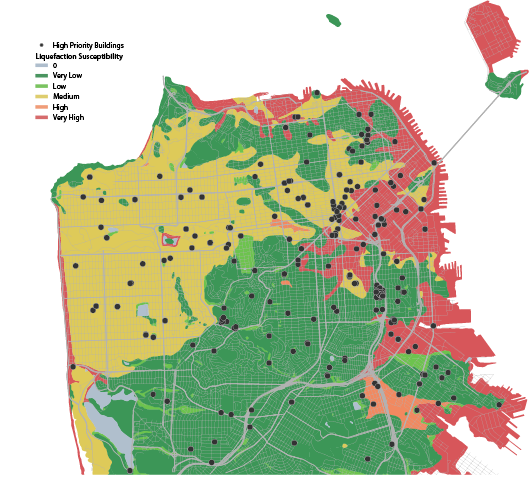Earthquake Safety

HAZUS and Liquefaction map
Because the risk of a major earthquake is imminent and the potential damage significant, San Francisco is constantly seeking new ways to protect our residents, workers, and buildings. The Earthquake Safety Implementation Program (ESIP) is a comprehensive 30-year, 50-task plan that grew out of the Community Action Plan for Seismic Safety (CAPSS) to address the City’s most pressing private building seismic risks in partnership with our communities. Priority ESIP tasks currently underway include the Soft Story Retrofit Program, Tall Building Safety Strategy, and the Private School Earthquake Safety Program.
In addition to improving the safety of private buildings, the Office of Resilience and Capital Planning is making efforts to address publicly owned infrastructure that is vulnerable to failure in an earthquake. The primary tools for such analysis include the HAZUS Earthquake Loss Estimation Study and Seismic Hazard Ratings. The HAZUS Earthquake Loss Estimation Study is a standardized analysis developed by FEMA to estimate the physical and economic impacts for specific earthquake scenarios. San Francisco is the first known municipality to have applied the HAZUS methodology at the individual building level, run first in 2013 and updated in 2017. The results from the most recent HAZUS analysis are shown in Table 4.1 and shown in the accompanying HAZUS map.
Table 4.1
| 2017 SF HAZUS Results | Hayward | San Andreas | San Andreas | San Andreas |
| (Dollars in Millions) | M6.9 | M6.5 | M7.2 | M7.9 |
| Structural Damage | 107.2 | 133.4 | 212.3 | 353.1 |
| Non-Structural Damage | 398.3 | 545.4 | 859.7 | 1,489.3 |
| Subtotal, Building Damage | 505.5 | 678.8 | 1,072.0 | 1,842.4 |
| Content Damage | 130.1 | 426.7 | 523.6 | 714.3 |
| Operational Losses (Rent, Relocation, and Lost Income) | 154.8 | 191.9 | 314.7 | 527.2 |
| Total Economic Impact (239 Buildings) | 790.4 | 1,297.3 | 1,910.3 | 3,083.8 |
Seismic Hazard Ratings (SHRs) were first developed in San Francisco in 1992 and are used to assess risk and prioritize seismic-strengthening capital improvements for over 200 public buildings. Buildings are rated on a scale from one (best) to four (worst). At present the City has addressed nearly all of the buildings previously identified as SHR4, with the exceptions of 101 Grove Street and 170 Otis, and many of those buildings rated SHR3. Updating the ratings is important for the future prioritization of seismically vulnerable structures, and some additional vulnerabilities have been identified this way. City facilities including, police and fire stations, and public health clinics have all been found in need of seismic safety work. That information has been incorporated into the prioritized projects of this Plan.
One of these priority projects includes the historic Kezar Pavilion, situated in the southeastern corner of Golden Gate Park. Kezar Pavilion needs a seismic upgrade to ensure safety for staff and public use in addition to comprehensive systems upgrades and historic rehabilitation. With a seating capacity of more than 5,000, this facility could be used for functions such as shelter, mass care and mutual aid after a major disaster.
Another essential disaster preparedness project is San Francisco’s Emergency Firefighting Water System (EFWS), which is vital for protecting against loss of life and property from fire in the event of a major earthquake. The San Francisco Public Utilities Commission assumed responsibility of the EFWS in 2011 and is steadily moving forward with plans to improve and expand its reach. For more information, please see the Infrastructure and Streets chapter and the Public Safety chapter.
The Building Occupancy Resumption Program (BORP) prioritizes critical facilities and reduces inspection times for reoccupation following a major earthquake. Building owners may apply to the BORP through the Department of Building Inspection to expedite a private inspection for reoccupation to within eight daylight hours of an earthquake through a contract with a qualified engineer, a process that can otherwise take days or weeks in the wake of a citywide emergency. This program is the first of its kind in California for private and public buildings and will enable San Francisco to restore services with minimal delay. Many of San Francisco’s critical public buildings and privately-owned buildings are part of the BORP program. Recent additions include the Moscone Convention Center and the California Academy of Sciences. San Francisco is hoping to expand participation in the program in the coming years.
A rising priority for both public and private buildings is addressing vulnerable concrete buildings. There are approximately 3,700 publicly and privately owned older concrete buildings built before modern building codes in the city. Some of these buildings have the potential to fail and collapse in an earthquake. The next step for San Francisco is to leverage best engineering practices to develop a screening and evaluation program to identify the most vulnerable buildings and develop a seismic retrofit program.

